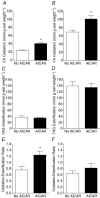AMP kinase activation with AICAR further increases fatty acid oxidation and blunts triacylglycerol hydrolysis in contracting rat soleus muscle
- PMID: 15774529
- PMCID: PMC1464526
- DOI: 10.1113/jphysiol.2004.081687
AMP kinase activation with AICAR further increases fatty acid oxidation and blunts triacylglycerol hydrolysis in contracting rat soleus muscle
Abstract
Muscle contraction increases glucose uptake and fatty acid (FA) metabolism in isolated rat skeletal muscle, due at least in part to an increase in AMP-activated kinase activity (AMPK). However, the extent to which AMPK plays a role in the regulation of substrate utilization during contraction is not fully understood. We examined the acute effects of 5-aminoimidazole-4-carboxamide riboside (AICAR; 2 mm), a pharmacological activator of AMPK, on FA metabolism and glucose oxidation during high intensity tetanic contraction in isolated rat soleus muscle strips. Muscle strips were exposed to two different FA concentrations (low fatty acid, LFA, 0.2 mm; high fatty acid, HFA, 1 mm) to examine the role that FA availability may play in both exogenous and endogenous FA metabolism with contraction and AICAR. Synergistic increases in AMPK alpha2 activity (+45%; P<0.05) were observed after 30 min of contraction with AICAR, which further increased exogenous FA oxidation (LFA: +71%, P<0.05; HFA: +46%, P<0.05) regardless of FA availability. While there were no changes in triacylglycerol (TAG) esterification, AICAR did increase the ratio of FA partitioned to oxidation relative to TAG esterification (LFA: +65%, P<0.05). AICAR significantly blunted endogenous TAG hydrolysis (LFA: -294%, P<0.001; HFA: -117%, P<0.05), but had no effect on endogenous oxidation rates, suggesting a better matching between TAG hydrolysis and subsequent oxidative needs of the muscle. There was no effect of AICAR on the already elevated rates of glucose oxidation during contraction. These results suggest that FA metabolism is very sensitive to AMPK alpha2 stimulation during contraction.
Figures




Similar articles
-
AMP kinase activation with AICAR simultaneously increases fatty acid and glucose oxidation in resting rat soleus muscle.J Physiol. 2005 Jun 1;565(Pt 2):537-46. doi: 10.1113/jphysiol.2004.081679. Epub 2005 Mar 17. J Physiol. 2005. PMID: 15774530 Free PMC article.
-
AMPK activation is not critical in the regulation of muscle FA uptake and oxidation during low-intensity muscle contraction.Am J Physiol Endocrinol Metab. 2005 Mar;288(3):E592-8. doi: 10.1152/ajpendo.00301.2004. Epub 2004 Nov 16. Am J Physiol Endocrinol Metab. 2005. PMID: 15547141
-
Short-term AMP-regulated protein kinase activation enhances insulin-sensitive fatty acid uptake and increases the effects of insulin on fatty acid oxidation in L6 muscle cells.Exp Biol Med (Maywood). 2010 Apr;235(4):514-21. doi: 10.1258/ebm.2009.009228. Exp Biol Med (Maywood). 2010. PMID: 20407084
-
AMP-activated protein kinase and muscle glucose uptake.Acta Physiol Scand. 2003 Aug;178(4):337-45. doi: 10.1046/j.1365-201X.2003.01168.x. Acta Physiol Scand. 2003. PMID: 12864738 Review.
-
Targeting the AMP-activated protein kinase for the treatment of type 2 diabetes.Curr Drug Targets Immune Endocr Metabol Disord. 2002 Jul;2(2):119-27. Curr Drug Targets Immune Endocr Metabol Disord. 2002. PMID: 12476786 Review.
Cited by
-
High Fat Activates O-GlcNAcylation and Affects AMPK/ACC Pathway to Regulate Lipid Metabolism.Nutrients. 2021 May 21;13(6):1740. doi: 10.3390/nu13061740. Nutrients. 2021. PMID: 34063748 Free PMC article.
-
Targeting the AMPK pathway for the treatment of Type 2 diabetes.Front Biosci (Landmark Ed). 2009 Jan 1;14(9):3380-400. doi: 10.2741/3460. Front Biosci (Landmark Ed). 2009. PMID: 19273282 Free PMC article. Review.
-
AMP-activated protein kinase control of fat metabolism in skeletal muscle.Acta Physiol (Oxf). 2009 May;196(1):147-54. doi: 10.1111/j.1748-1716.2009.01973.x. Epub 2009 Feb 19. Acta Physiol (Oxf). 2009. PMID: 19245653 Free PMC article. Review.
-
Advantages of Phosphodiesterase Type 5 Inhibitors in the Management of Glucose Metabolism Disorders: A Clinical and Translational Issue.Int J Endocrinol. 2020 Jul 28;2020:7078108. doi: 10.1155/2020/7078108. eCollection 2020. Int J Endocrinol. 2020. PMID: 32774364 Free PMC article. Review.
-
Studying the Geroprotective Properties of YAP/TAZ Signaling Inhibitors on Drosophila melanogaster Model.Int J Mol Sci. 2023 Mar 22;24(6):6006. doi: 10.3390/ijms24066006. Int J Mol Sci. 2023. PMID: 36983079 Free PMC article.
References
-
- Ai H, Ihlemann J, Hellsten Y, Lauritzen HPMM, Hardie G, Galbo H, Ploug T. Effect of fiber type and nutritional state on AICAR- and contraction-stimulated glucose transport in rat muscle. Am J Physiol Endocrinol Metab. 2002;282:E1291–E1300. - PubMed
-
- Bergeron R, Russell RR, III, Young LH, Ren J-M, Marcucci M, Lee A, Shulman GI. Effect of AMPK activation on muscle glucose metabolism in conscious rats. Am J Physiol. 1999;276:E938–E944. - PubMed
-
- Corton JM, Gillespie JG, Hawley SA, Hardie DG. 5-Aminoimidazole-4-carboxamide riboside: a specific method for activating AMP-activated protein kinase in intact cells? Eur J Biochem. 1995;229:558–565. - PubMed
-
- Dyck DJ, Bonen A. Muscle contraction increases palmitate esterification and oxidation and triacylglycerol oxidation. Am J Physiol. 1998;275:E888–E896. - PubMed
Publication types
MeSH terms
Substances
LinkOut - more resources
Full Text Sources
Medical

